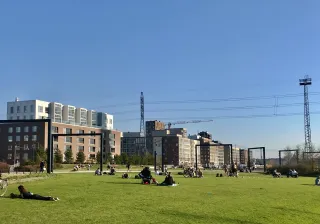Finland may see nuclear district heating roll-out in the coming decade.
Tuesday, May 6, saw a news release that may have gone unnoticed by many. The Finnish, VTT-backed technology company Steady Energy announced a joint pilot project with energy company Helen. Steady Energy will build a pilot facility for a small modular reactor (SMR) plant inside the former Salmisaari coal plant in central Helsinki.
The pilot facility will produce heat for Helen’s district heating network once completed. During the pilot phase, the facility will not contain nuclear fuel. Instead, the water within it will be heated by electrical resistors.
The timing of the announcement was no coincidence. On that same Tuesday, hundreds of SMR professionals and stakeholders gathered in Hanasaari, Espoo, for the SMR Business Day 2025 event.
Small modular reactors are nuclear reactors with an electrical power of less than 300 megawatts. The idea of modularity is that the reactor or at least the primary systems can be built to near-completion in a factory and transported to site as modules. This would speed up construction and reduce costs.
The need for emission-free energy is growing. In the United States, Amazon, Google and Microsoft have recently signed agreements with nuclear operators to secure electricity for their data centres.
Finland's electricity system is already almost emission-free, but small reactors can help achieve carbon neutrality targets in many other ways. Nuclear energy could replace burning wood to produce district heating. Reactors could serve as power sources for ships. They could be used to produce process steam or hydrogen.
Technology developed over years is gradually finding its way to the market. Could it be that Finnish homes get to bask in the warmth of district heating generated with SMRs in the 2030s?
The first players are paving the way towards the commercialisation of small modular reactors. Finding funding for building pilot and demonstration facilities is critical. After the first successful projects, economies of scale should start emerging.
The technology itself is tried and tested. The question is not really about technology but about man-made rules: policy choices, regulation, market mechanisms. The nuclear industry is global, but politics and regulation are in national hands. Economies of scale will not be achieved if each plant must be customized to local requirements.
The Finnish nuclear energy legislation is currently undergoing a comprehensive reform. It is encouraging to see that there is an open discussion on how to streamline the licensing process for new nuclear technologies. This is a good start, but the discussion must also take place at the European level. The commercialisation of innovative nuclear technologies must be made easier, and research funding must be boldly directed towards creation of new innovations.







